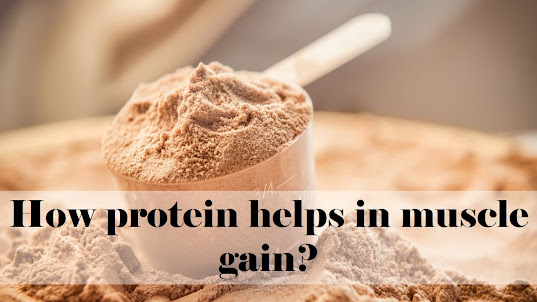Also read- Best Protein Supplement Under 1500 rupees
How Does Protein Help to Build Muscle?
Understanding the science, how much you need, when to eat it, and common myths.
1. Why Protein Matters for Muscle Growth
Muscle is primarily composed of protein — structures like actin and myosin form the contractile elements of your muscle fibers. During resistance training (like lifting weights or bodyweight workouts), small micro-tears occur within these fibers. Your body repairs this damage by fusing fibers together, increasing the muscle’s size and strength over time. For this repair process, your body needs a steady supply of amino acids — the building blocks of protein.
Protein doesn’t just repair muscle; it also triggers the process of muscle building. The amino acid leucine activates the mTOR pathway, which signals your body to start muscle protein synthesis (MPS). In simple terms: Training + Protein + Rest = Muscle Growth.
2. How Much Protein Do You Need?
There is no single universal number, but research provides a strong range for active individuals:
- A 2020 meta-analysis found that protein intakes from about 0.5 to 3.5 g/kg of body weight were positively associated with lean mass gain (Nutrition Reviews, 2020).
- A 2022 systematic review concluded that for resistance-trained adults, intakes around 1.6 g/kg/day or higher produced measurable gains in lean mass (PubMed, 2022).
- Most evidence shows diminishing returns beyond 2.0 g/kg/day (Sports Medicine Open, 2022).
Practical Tip: Aim for 1.4–2.0 g protein/kg body weight/day if you lift weights or perform resistance exercises regularly. For example, a 70 kg person would need roughly 100–140 g of protein per day.
3. When and How to Distribute Protein
Your total daily protein intake matters more than precise timing, but distribution also plays a role in optimizing MPS throughout the day.
- A 2013 meta-analysis found that once total daily intake was matched, timing (like post-workout shakes) made minimal difference (Journal of the International Society of Sports Nutrition).
- However, spreading protein evenly across meals (20–40 g per meal) maximizes MPS and recovery (Sports Medicine Open, 2022).
Practical Approach: Eat moderate protein portions every 3–4 hours, including one post-workout and one before bed.
4. Food Sources and Quality of Protein
Not all proteins are created equal. Their quality depends on digestibility and amino acid composition:
- High-quality animal sources: Eggs, dairy (milk, yogurt, paneer), fish, lean meats, and whey protein — all high in leucine.
- Plant-based sources: Lentils, beans, soy products, tofu, quinoa, and nuts. Combining sources ensures a complete amino acid profile.
Tip for Indian diets: Combine dal + rice, include dairy, soy chunks, or eggs. Aim for 25–30 g protein per major meal and 10–15 g in snacks (e.g., milk + nuts, yogurt, or a protein smoothie).
5. Myths and Common Mistakes
- Myth 1: “More protein = more muscle” — Studies show limited benefits beyond 2 g/kg/day (Sports Medicine Open).
- Myth 2: “Timing is everything” — Total daily intake matters most; timing adds only a small benefit (JISSN, 2013).
- Myth 3: “Supplements are mandatory” — Supplements are convenient, not essential. Whole-food sources are equally effective.
- Note: In older adults, high protein alone offers limited benefits unless combined with exercise (PMC, 2022).
6. How to Apply It in Real Life
- Calculate your target: Body weight × 1.4–2.0 g = grams of protein/day.
- Spread intake: 3 main meals + 1–2 snacks (25–30 g each meal).
- Train smart: Use progressive overload; strength training 3–4× per week.
- Recover: Sleep, adequate calories, hydration.
- Stay consistent: Muscle growth takes months, not weeks.
7. Summary / Key Takeaways
- Protein provides amino acids that build and repair muscle tissue.
- Aim for 1.4–2.0 g/kg/day depending on your training load.
- Distribute protein across meals and include post-workout intake.
- Prioritize food sources; use supplements only when needed.
- Combine high-protein intake with consistent training and recovery.









0 Comments